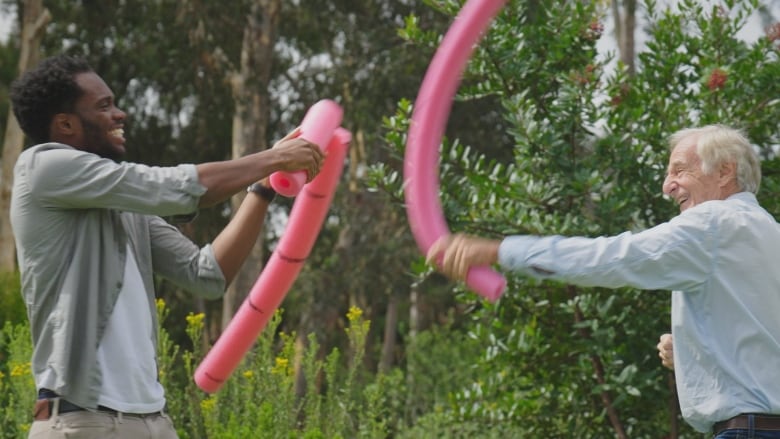Anthony Morgan is having a bad hair day. Sarika Cullis-Suzuki is wondering how to fight the frizz. And many of us can relate.
A 2018 survey by InStyle magazine found that 75 per cent of women consider hair important to their well-being. In a 2005 study of European men, over 70 per cent reported hair to be “an important feature of image.” It’s no wonder so many of us go to such great lengths trying to fix our hair struggles.
In Hairy Tales, a documentary from The Nature of Things, hosts Cullis-Suzuki and Morgan explore the fascinating science of hair. Along the way, they reveal their own hair dilemmas and untangle surprising new research, which suggests the science of hair is anything but cut and dried.
Host hair dilemmas
For years after giving birth to twins, Cullis-Suzuki was shocked to discover clumps of hair in the drain after having a shower. “It took five years for my hair to come back to what it used to be. Five years!” she says in the documentary. “I lost a ton of hair.”
Morgan worries that DNA will determine the destiny of his hair. “My cousin was bald by, like, 18. My brother was bald by 21,” he says. “I’m lucky to have [what I have] left.”
Is there anything you can do to change the fate of your follicles? To find out, Cullis-Suzuki and Morgan consult a diverse cast of experts, including doctors, geneticists and leading researchers to untangle what hair is exactly and how they can get theirs under control.
A primer on human hair
Morgan takes a trek through the desert to meet biological anthropologist Tina Lasisi and explore why hair evolved on our scalps in the first place.
“We talk about humans as the naked ape,” she says. “But we’re the only weirdos that keep hair on our heads.”
Our ancestors evolved to walk on two legs in equatorial Africa, where the sun would have been beating down on them and they would have had to find ways to stay cool if they wanted to survive.
The hair on our heads stuck around because it prevents solar radiation from reaching our scalps (and overheating our brains). Straight hair keeps a lot of that heat trapped, whereas tightly curled hair has air pockets that, Lasisi speculates, let the hot air escape.
“Obviously, so many of us — looking at you, Canada — do not live in places that are always very hot,” Lasisi said. “So it’s possible that once different groups of humans left to different parts of the world, there was a selective pressure maybe again to have the kind of hair that would keep us warm.”
All human hair is incredibly strong. “On a weight basis, it’s as strong as steel,” materials scientist Marc Meyers said. But perhaps surprisingly, the thicker a strand of hair is, the weaker it gets.
“It has to do with existing flaws in the hair,” Meyers said. “The larger, thicker hair has more internal flaws, so it will break easier.”
To demonstrate, Meyers and Morgan duelled with pool noodles of different diameters to see how they would fare.

Visiting the dermatologist
Cullis-Suzuki heads to a dermatology clinic for a visit with Dr. Renée Beach, who ran a hair-loss clinic at a Toronto hospital for nearly a decade. She examines the science — and social consequences — tied to our tresses. “I think we’re obsessed because it’s undeniable that people get judged based on their hair,” she says.
Beach explains that there are many different types of hair loss, experienced by both men and women. “It is very, very acceptable … for a man to lose their hair or decide to shave it or go bald,” she says. “We’re still not there with women.”

If anyone knows why hair grows — or doesn’t — it’s hair-loss expert Dr. Carolyn Goh, who has been bald since childhood due to alopecia areata, an autoimmune condition. She explains the remarkable transformation that takes place in the roughly 100,000 follicles embedded in most people’s scalps.
“The hair follicle is very unique because it regenerates itself completely.” Goh says in the documentary. “It actually goes through cycles. It goes through a growing phase, which usually lasts several years, and that dictates how long your hair can be. At any point in time, 90 per cent of your hairs are in that growth phase. And then it goes through a transitioning phase [and then] a resting phase, which is usually a couple of months. At the end of that resting phase, that old hair falls out and that new hair pushes it out.”
The hosts explore their families’ hair histories
Morgan and Cullis-Suzuki both go back to their roots, exploring their family histories to learn more about how genetics influences hair growth, texture and colour. Cullis-Suzuki tags along for a haircut with her scientist dad, David Suzuki, while Morgan hosts a family barbecue and seeks the advice of his childhood barber.
As we discover, DNA isn’t the only determinant of hair health. Hormones, stress and even climate change can play a role.

Hairy Tales answers some fundamental questions about hair. What is hair made of? Why does it go grey? Why do we get split ends? Why do we care about our hair so much?
Watch the documentary on CBC Gem.
